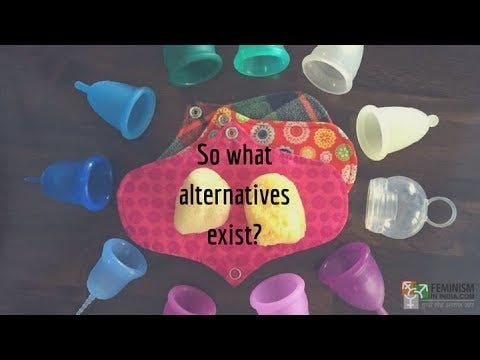Isn’t it time to make the eco-friendly switch?
Environmental impact caused by sanitary waste is one of the significant topics in discussions today. A plastic, industrially manufactured, disposable sanitary pad requires about 500–800 years to decompose. Thousands of tons of disposable sanitary waste is generated every month all over the world.
432 million pads/ sanitary napkins are generated in India annually, the potential to cover landfills spread over 24 hectares.
This is a ridiculous amount of pollution which is hazardous with toxic chemicals leaching the soil, strong and harsh odours emitted by the waste disposed of in landfills or buried in the soil.
This waste is toxic and hazardous to human health as well. Most of the chemicals from these pads reaching the soil causes groundwater pollution, loss of soil fertility. Disposal of this sanitary waste is also a big question mark. A Solid Waste Management official from the BMC is quoted to have said, “There is no clarity on whether sanitary napkins should be classified under bio-medical waste or dry waste, there is also no awareness regarding the disposal even among those who stay in societies, whereas in slum areas it is usually thrown in nullahs (open drains)”. While incineration is being proposed as a solution, the costs of scientifically-managed incineration are risk-prone, with bio-medical waste incineration firms charging as much as Rs 22/kg of sanitary waste in cities like Bengaluru. This could cause respiratory harm and skin allergies. Many women flush down disposable sanitary napkins after use, clogging underground drains and manual scavengers bearing the health cost for the same.
With awareness and health campaigns all across India being active in popularising the idea of sustainable menstruation, there are healthy ways to utilise menstrual care products without any impact on the environment. Menstrual blood is said to be a healthy fertiliser for the soil and provides a nutritious environment for plants and shrubs to grow in. The journey of menstruation and environmental health goes a long way, with some revolutionary trends coming up in the recent past. The Cup and Cloth Campaign by the organisation Green the Red provides ample information and detailed concepts of sustainable menstruation in India. Such initiatives provide a positive outlook towards sanitary waste disposal being replaced by reusable, low energy input menstrual products such as menstrual cups, cloth pads, and period panties. These are brilliant innovations with safe health benefits and cost-effective utilisation.
Many Indian women still use scrap cloth from old saris and towels, the traditional method for managing menstruation since times immemorial. Sustainable menstrual products provide a platform to utilise safe and affordable items which are easily accessible to poor women. Many organisations such as SaathiPads and EcoFemme provide employment, generating a livelihood for these women which allows them access to good and sustainable menstrual care. Most sustainable menstrual products are initiated through rural livelihood management initiatives, where menstrual health and a pollution-free, hassle-free environment for these women is possible and implemented. The benefits of these products are seen in all spheres, enhancing the lives of these women with greater accessibility, better opportunities and better health care provisions.

Advantages sustainable menstrual products offer:
1. Menstrual Cups
- The most cost-effective and inexpensive, with a lifetime up to 10 years without any health hazards.
- Medical grade silicon is utilised to make menstrual cups, with lowest chances to contract any vaginal infections, diseases or itching out of all products currently available in the market.
- Since the cup holds the menstrual blood at the cervix, it prevents the blood from flowing through the vaginal canal, allowing for hassle-free sexual intercourse.
- Extremely travel-friendly, allowing it to remain for hours without any discomfort or worry. Does not need to be changed often.
- Usually leak-proof, which ample storage and does not emit an odour.
2. Cloth Pads
- Women with sensitive skin might benefit from cloth pads because, unlike regular pads, they’re made of cotton and not plastic and don’t irritate the skin.
- Cloth pads are free of irritating materials, so you can avoid unnecessary exposure to the synthetic ingredients in disposable pads and tampons.
- While they do have a high one-time cost, they are inexpensive in the long run since they can be washed and reused.
- If you are already annoyed about of handing your money over to big mass-producing corporations who probably don’t have your best interests in mind, check out the companies that specialise in providing safe and healthier alternatives. You will be supporting local artisans generate income along with providing livelihoods for other women.
3. Period Panties:
- Period panties are designed in triple layers of fabric. These are worn with cloth pads for best results.
- The first layer is absorbent which absorbs every liquid.
- The second layer is water-proof thus avoiding leakage.
- The third layer is cotton — which is responsible for providing optimum comfort to the wearer. The three layers of fabric ensure that there is no leakage. All materials used for designing a period panty are breathable and comfortable.
- A Period Panty ranges between Rs 200 and Rs 600, a modest pricing for a product of great utility. They are also easily available for purchase.
Approximately 20 pads/tampons per month, equating to 240 per year which over the average lifespan of a menstruating female (approximately 40 years of periods) gives us the grand total of 9,600 feminine hygiene products used during one woman’s lifetime. Now multiply that by the 3.5 billion women on the planet and we have a considerable amount of potentially avoidable waste!
The environmental benefits of these products create a significant, applaudable and positive impact on the planet, where every woman’s contribution to this transition from disposable to sustainable menstrual products matters.

Let’s make the Earth a greener, better and safer place, one red revolution at a time!
For more information on how to make the switch and on utilising a variety of products, click here and here.
Feature Image Credit: menstrupedia.com
Ayesha Mehrotra is a Volunteer Researcher at One Future Collective and a passionate environmentalist. Through her writing on this platform, she hopes to encourage all generations to understand the importance of equality, liberty, justice, and happiness.